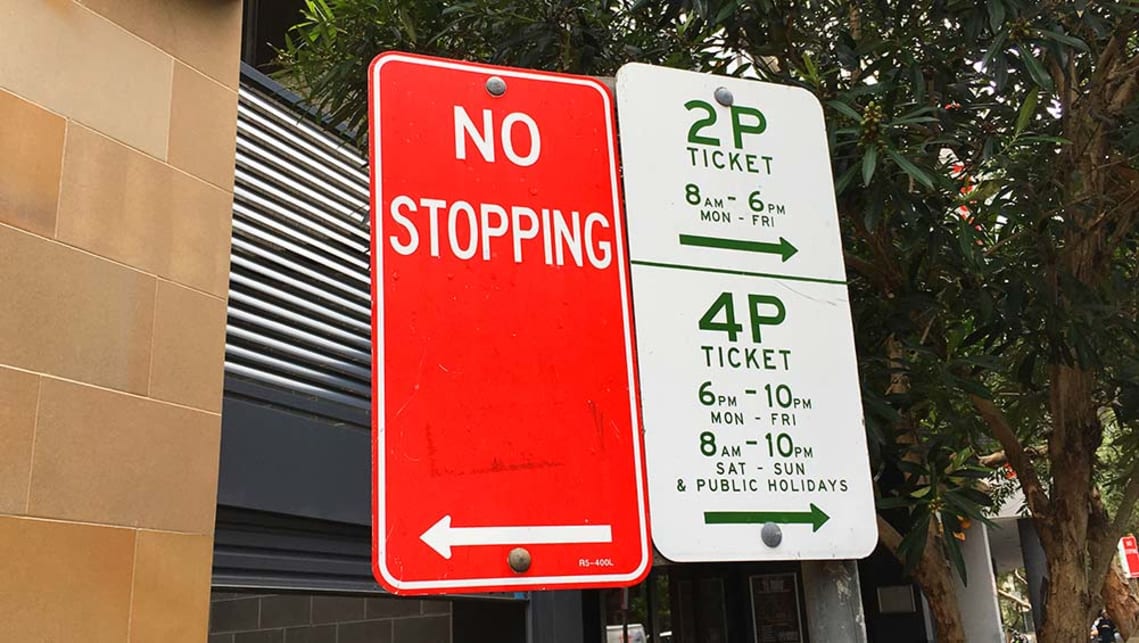
Parking laws you should know

There is only one way to truly guarantee getting out of paying a parking fine, and it doesn't involve concocting an awesome excuse, recruiting a crack team of expensive legal experts or scrunching up said fine and hurling it at whoever put it on your windscreen in the first place.
Nope, the only way to ensure you definitely won't be paying a fine isn't half as exciting as any of those options. It's not getting fined in the first place.
Now, that's easier said than done, and millions upon millions in parking fine dollars flow into council coffers around the country each year. So in the interests of keeping your hard-earned cash safely tucked away in your bank account, instead of your local council’s pocket, we present our guide to parking rules you should know.
The following is a general breakdown, but it’s always worth checking with your local council to see what, if any, specific rules apply. We haven't listed every rule, and nor have we listed the obvious ones (as in, the ones where the parking sign tells you exactly what to do). But we have tried to pinpoint some of the less-common, state-specific rules you should really be across.
NSW
Parking pain in NSW is greater than anywhere else in Australia. Not only is finding a spot in Australia’s most populated state harder than it is anywhere else, but should you break the rules, you’ll be paying a fine up to three times higher than in Victoria.
In the 2014/15 financial year, for example, NSW motorists paid more than $31 million just for parking in no stopping zones. That joins the $27 million paid for parking longer than permitted, the $20 million for parking without displaying a ticket, and the $9 million for parking incorrectly in a loading zone.
All up, $180 million poured into state and council coffers thanks to parking fines. And to rub extra salt into the wound, certain offences in NSW now also carry hefty demerit point penalties, too.
And you don’t want to be adding to the budgets, do you? Exactly. So here are the rules you might not know in NSW. You can’t stop your vehicle, whether you stay in the car or not, if you are:
On or across a driveway (unless you are dropping off or picking up, then you get two minutes). Be warned this also applies to your own driveway - as this author once found out the hard way.
- At a bus stop, or within 20m before or 10m after a bus stop.
- In a safety zone or within 10 metres before or after a safety zone.
- On or within 20m (before) or 10m (after) a pedestrian crossing.
- Within 20m of an intersection with traffic lights, unless a sign allows you to park there. And within 10m of an intersecting road at an intersection without traffic lights unless a sign allows you to park there.
- Within one metre of another vehicle parked in front or behind (does not apply when angle parking).
- Within three metres of any double centre lines.
- Within three metres of an Australia Post letter box unless dropping off or picking up passengers or mail.
- Within one metre of a fire hydrant, fire hydrant indicator or fire plug indicator.
- Within 20 metres before or after a railway level crossing.
Victoria
The fines might, on average, be lower than in neighbouring NSW, but that doesn’t mean Victorian rangers are any more sympathetic. While most Victorian councils don’t clearly separate the money raised from fines and from parking fees in their annual reports, a survey of 21 major council areas found they’d raised a combined $257 million in the 2014/15 financial year, with fines thought to have made up the bulk of that number.
So let's not add to it. Here are the parking rules you might not know in Victoria. You can’t stop your vehicle if you are:
- Within 20m before a sign displaying the words 'tram stop' or 'tram stop request.'
- Parked less than three metres from continuous dividing line or dividing strip.
- Stopped within 10m before marked foot crossing, or within three metres after foot crossing.
- Stopped within 10m before a bicycle crossing or within three metres after a bicycle crossing.
- Stopped within one metre of a fire hydrant, fire hydrant indicator or fire plug indicator.
- Stopped within 20m of an intersection with traffic lights.
- Stopped within three metres of a public postbox.
- Parked less than one metre from another vehicle.
- Parked with less than three metres of road left for another vehicle to pass.
- Stopped next to a yellow edge line.
- Parked unreasonably obstructing the path of pedestrians.
- Stopped within 20m before or after level crossing.
- Stopped within 10m before or after a safety zone.
- Stopped on or near a crest not in a built-up area.
- Stopping within 20m before or 10m after a children's crossing.
- Stopped within 20m before or 10m after a pedestrian crossing.
Queensland
Queensland. Beautiful one day, $48 million in annual parking revenue from Brisbane City Council alone the next. That’s how much fell into council coffers in the 2014/15 financial year. To be fair, that number was down a clean million dollars on the year before, but we’d like to see it fall a little further.
Here are the parking rules you might not know in Queensland. You can't stop your car:
- On a crest or curve outside a built-up area.
- In a loading zone for longer than two minutes while dropping off, or picking up, passengers.
- Not completely within a single parking bay or within the minimum number of parking bays needed to park the vehicle.
- Stopping within three meters of a post box [unless dropping off, or picking up, passengers or mail, or signed otherwise].
South Australia
If there’s such a thing as a good parking ticket, you’ll find it in Adelaide, where fines start at just $52. Less good, however, is the trigger-happy parking inspectors: a newspaper’s Freedom of Information request found that, in a year, $443,460 in fines were issued to people whose parking tickets had expired by less than 10 minutes.
But forewarned is forearmed, so here are some rules you might not know in South Australia. You can’t stop your vehicle if you are:
- Anywhere, on any road or street, for longer than 24 hours. After 24 hours there is a possibility the vehicle may be impounded. Applies to the Adelaide CBD.
- On any road with a continuous yellow edge line.
- In front of a driveway or entrance (forget the ticket, you could be towed instead).
- Within 10m of an intersection without traffic lights.
- Within 20m of an intersection with traffic lights.
- On or within 20m of the approach or 10m of the departure side of a pedestrian or school crossing.
- Within 20m before a bus stop or 10m after, or any sign stating hail bus here.
- Within one metre of a fire hydrant.
- Anywhere between a road and a property boundary, including lawns and gardens.
Western Australia
Perth is the parking fine capital of WA, with rangers issuing more than $10 million in parking fines in the 2015/16 financial year in the Perth council area alone. That’s more than 275 very unhappy parkers every single day.
So to prevent that becoming 276, here’s a quick guide to parking in Perth:
- While you can park on a street verge or nature strip, you need to have permission from whoever is occupying the property immediately adjacent to you car. Unless of course the council has already installed no parking signs, in which case it's game over, whether you live there or not.
- You also can’t park your car with a for sale sign in the window - something that’s unbelievably common in other states. And that includes roadways, median strips and verges, even if they’re parked legally.
- You can’t park within 10m of a corner with no traffic light installed.
- You can’t park within 20m of a corner with a traffic light installed.
- You can’t park within one metre of a fire hydrant or fire plug.
Northern Territory
Rangers in Darwin issued more than 25,000 fines in 2015, and have recently rolled out a series of parking zones across the CBD, with free parking obliterated. And that can only mean fine numbers will be climbing.
The result, though, is a significantly easier system, with parking costing more the closer you get to the middle of town. That said, the 'more' they speak of maxes out at $2.50 per hour - peanuts compared to the cost of parking in Sydney.
Be warned, though, if you go over your limit, a ticket is coming your way. Ignore it for 24 hours and your car can be deemed 'abandoned.' And that means it might not be there when you get back.
ACT
The ACT Government issued 100,000 parking fines in the 2015/2016 financial year. The good news? At least some of those were bound to be issued to politicians. But with, on average, 15 inspectors patrolling the ACT every day, each is issuing about 18 tickets per day.
So it pays to know the rules, then. Here are a few of the lesser-known parking rules in the ACT:
- You can't park your car within 20m of an intersection with traffic lights, and the within 10m of an intersection without traffic lights.
- If a road has a continuous dividing line or strip, a motorist must not park a vehicle within three metres of the line or strip unless there are signs or other traffic control devices indicating otherwise. If the road does not have a continuous dividing line or strip, there must be at least three metres of road alongside the vehicle that is clear for other vehicles to pass, unless information on a parking control sign indicates otherwise.
- A motorist parked in a paid parking area must not display anything falsely resembling a parking ticket or a parking ticket that has been changed, damaged or defaced in any way.
Tasmania
Hobart Council takes parking fine revenue seriously. So much so that it's called for tenders to roll out 1700 in-ground pressure sensors that will record the moment a driver pulls into a timed parking space, and then alert rangers as soon as it overstays its welcome.
So let’s level the playing field. Here are some of the lesser-known parking rules in Tasmania. You can’t stop your car:
- On or across your own or another person’s driveway, or so close to the driveway that you obstruct a vehicle from driving in or out.
- On a children's crossing, within 20m before the crossing, within 10m after the crossing.
- Within 20m of the nearest point of an intersecting road at an intersection with traffic lights.
- Within 10m from the nearest point of an intersecting road at an intersection without traffic lights.
- With even two wheels mounted on the footpath










Comments